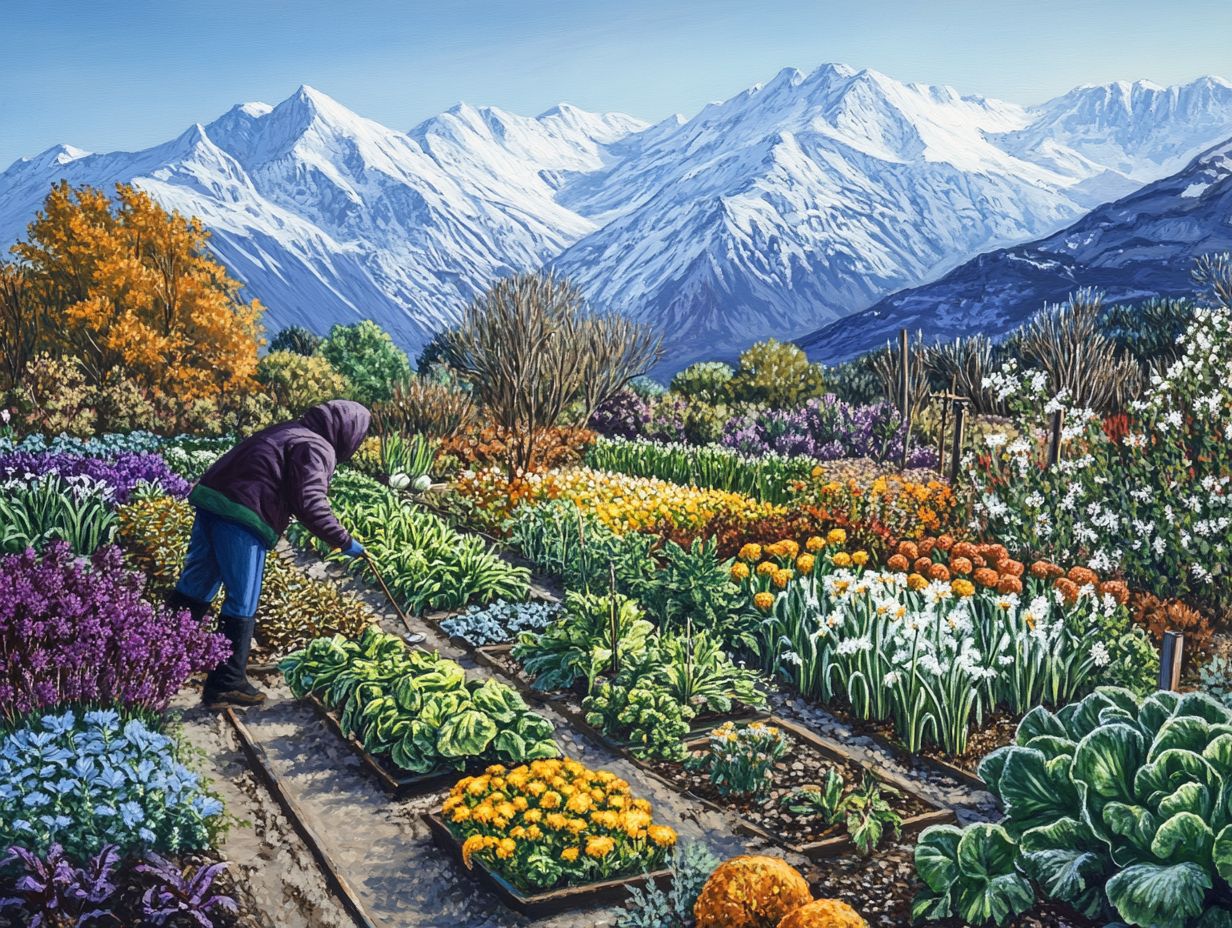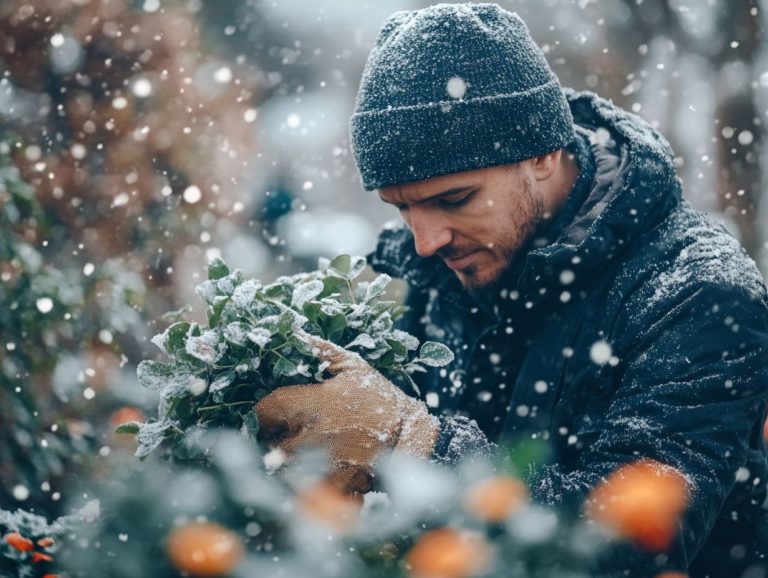What is Cold-Climate Gardening?
Gardening in cold climates presents unique challenges and opportunities that can turn your outdoor space into a thriving ecosystem, even as temperatures dip.
This article delves into the world of cold-climate gardening, emphasizing its importance for both seasoned gardeners and those just starting out. Understanding your garden zone is crucial.
You ll discover common obstacles you might face and learn about hardy plants that thrive in chillier conditions. Practical tips for success will be at your fingertips, guiding you every step of the way.
You ll also discover essential winter preparation tasks that will keep your garden vibrant throughout the year. Imagine creating a lush oasis of greenery, even when frost threatens!
Contents
Key Takeaways:

- Cold-climate gardening refers to the practice of growing plants in regions with long, cold winters and short growing seasons.
- Common challenges include frost, frozen soil, and brief growing seasons, but these can be overcome with proper planning and techniques.
- Root vegetables, hardy fruits, and other hardy plants are excellent choices for a successful cold-climate garden.
Understanding Cold-Climate Gardening
Understanding cold-climate gardening is vital for you to grow a thriving garden in regions with harsh winters like Wyoming, Alaska, and Utah. To achieve the best results, it’s crucial to know what the best soil is for cold-climate gardens, as well as your specific garden zone and frost dates.
This knowledge is crucial for maximizing your growing season. It ensures a bountiful harvest. By employing techniques such as using raised beds and consulting local gardening experts, like those from Home Depot and Lowes, you can successfully navigate the challenges posed by your environment.
It s all about creating an oasis of greenery, even when frost threatens to blanket the landscape outside.
Defining the Concept and Its Importance
Defining cold-climate gardening requires you to recognize the unique challenges and strategies essential for successful growth in areas with shorter growing seasons and harsher weather conditions. Understanding why choose cold-climate gardening can also provide valuable insights into maximizing your garden’s potential.
Understanding local plant hardiness zones is vital if you aim to garden effectively, particularly through resources like the USDA Plant Hardiness Map, which shows which plants grow best in your area. This awareness helps you select the right species and encourages sustainable practices that benefit local ecosystems, including planting herbs and perennials.
By choosing plants well-suited to your climate, you contribute to plant variety, enhance soil health, and create welcoming habitats for native wildlife. Practicing effective cold-climate gardening can drastically reduce your need for chemical fertilizers and pesticides, promoting a more resilient landscape, especially when you grow your own home-grown parsley.
Challenges of Cold-Climate Gardening
Cold-climate gardening presents a unique set of challenges that you must navigate to achieve a thriving vegetable harvest. Understanding frost dates and managing soil temperature are critical factors that shape your gardening season, especially when planning for spring planting.
Cold-sensitive plants can struggle to survive without the right protection, making it essential to be mindful of local microclimates. If you’re gardening in states like Maine or Utah, these hurdles may be familiar, often necessitating innovative solutions like cold frames and hoop houses for your herb garden.
By employing these strategies, you can effectively extend your growing season and nurture your herb garden to its fullest potential.
Common Obstacles and How to Overcome Them

Key challenges in cold-climate gardening include unpredictable frost dates and the sensitivity of certain plants to cold. Managing soil temperature effectively is crucial.
To navigate these hurdles successfully, you can adopt several strategies. Understanding your local weather variations is a great start.
For instance, selecting frost-resistant plants like kale, pansies, and certain carrot varieties can lay a sturdy foundation for a thriving garden, even in the chill. Combine them with hardy perennials for even greater success.
Utilizing organic mulch helps regulate soil temperature, retains moisture, and suppresses weeds, making it a multifunctional ally in your gardening arsenal. This is especially important when growing spinach.
Employing season extenders, such as cold frames or row covers, creates a warmer environment for delicate seedlings. This allows them to flourish, even on brisk spring days.
These methods are game changers! They can skyrocket your gardening success amidst less forgiving climates.
Types of Plants Suitable for Cold Climates
In cold-climate gardening, choosing the right plants is essential for cultivating a thriving garden. This holds true even when faced with challenging weather conditions.
Consider hardy perennials, vegetables like spinach, kale, and carrots, as well as herbs such as home-grown parsley. These selections are well-suited for cold environments.
By understanding the specific needs of these plants, including herbs and perennials, you can elevate your vegetable gardening experience. This leads to a bountiful harvest.
Plan according to your garden zone and local frost dates. This ensures you re planting the right crops at the optimal time, setting yourself up for success in your gardening endeavors.
Vegetables, Fruits, and Flowers That Thrive in Cold Weather
Certain vegetables, fruits, and flowers are especially suited for cold climates. This enables you to cultivate a diverse and productive garden even amid harsh conditions.
Hardy vegetables like kale and Brussels sprouts not only endure frost but also develop a sweeter flavor after a freeze. This makes them ideal for vegetable gardening.
Root vegetables such as carrots and parsnips can remain in the ground throughout winter. They serve as a reliable source of nutrition when other options may be scarce.
On the fruit front, varieties like winterberry and certain apple cultivars thrive during the chillier months. And let s not forget about flowers pansies and violas bring vibrant color to winter gardens and often bloom bravely despite the cold.
By understanding their care requirements, including proper mulching and watering techniques, you can ensure these resilient plants flourish. They provide both beauty and sustenance throughout the year.
Tips for Successful Cold-Climate Gardening
Successful cold-climate gardening relies on a diverse array of tips that can significantly enhance your garden’s productivity, especially when considering the impact of climate change on cold gardening in challenging conditions.
By employing these strategies, you’ll ensure that your garden thrives despite the elements.
Best Practices and Techniques for Cold-Weather Gardening

Implementing best practices is essential for thriving in cold-weather gardening and maximizing the limited growing season.
If you’re looking to enhance your yields during those chilly months, consider utilizing season extenders like cold frames. They create a microclimate that protects your delicate plants from frost.
Starting seeds indoors gives them a valuable head start, resulting in robust seedlings ready to transition outdoors as soon as conditions allow.
Raised beds can significantly boost soil temperature, creating an ideal environment for root development. By embracing these strategic methods, including consulting resources such as Gardening Academy, you can make cold-weather gardening productive and rewarding.
Preparing Your Garden for Winter
Preparing your garden for winter is crucial. It helps your plants survive the cold and thrive when spring arrives.
Essential Tasks and Precautions Before Winter Hits
Before winter comes, take vital steps to ensure your garden not only survives but thrives.
- Secure cold frames and hoop houses. These structures protect your plants from harsh weather.
- Mulch around your perennials and vegetable beds. This insulates the soil and protects roots from freezing.
- Finish your vegetable harvest promptly. This preserves your crops and minimizes frost losses.
By taking these steps, you re not just protecting your plants; you re gearing up for an abundant harvest next season!
Frequently Asked Questions
What is Gardening in Cold Areas?

Gardening in cold areas involves growing plants in regions with harsh winters and short growing seasons.
What are common challenges of Gardening in Cold Areas?
Challenges include frost damage, short growing seasons, and temperature swings. These can hinder plant growth and invite pests.
What types of plants are suitable for Gardening in Cold Areas?
Choose hardy plants that thrive in cold, like evergreens and certain shrubs.
What are tips for successful Gardening in Cold Areas?
Select hardy plants, use mulch for protection, and start seeds indoors. Ensure proper drainage and shield against cold winds.
Can Gardening in Cold Areas be done year-round?
While gardening is mostly limited to warmer months, cold frames and greenhouses can extend the growing season.






